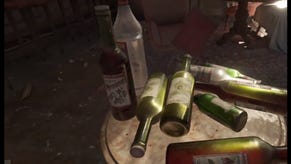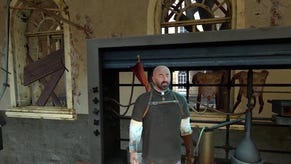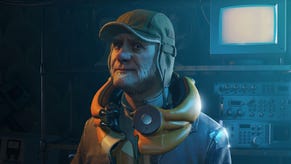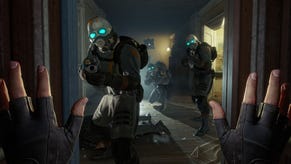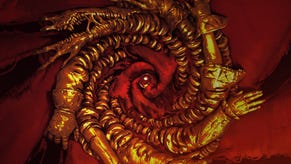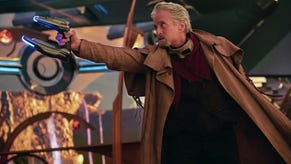Half-Life: Alyx Behind the Scenes, Part 2: "We're About to Pitch You This Ending, and You're Gonna Hate it"
We talked with Erik Wolpaw and Chris Remo about Jeff, some beloved Half-Life characters, and Alyx's shocking final scene.
This article first appeared on USgamer, a partner publication of VG247. Some content, such as this article, has been migrated to VG247 for posterity after USgamer's closure - but it has not been edited or further vetted by the VG247 team.
This is the second part of our extended interview with writer Erik Wolpaw and designer/programmer Chris Remo, two members of the Half-Life: Alyx team at Valve. In the first spoiler-free installment, we cover how Alyx's lead characters were cast, some challenges of designing for VR, what the former Campo Santo team is up to at Valve, and take the temperature on whether or not more Half-Life is on the way. This second and final installment will cover key points about Half-Life: Alyx's plot, including the events of the final scene—if you don't want to know how it ends, turn back now.
Spoiler Tag: Spoilers for every aspect of Half-Life: Alyx's story, including the ending.
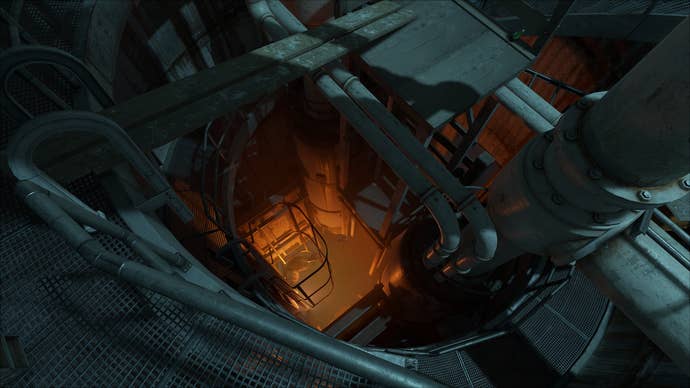
A little bit past the halfway point of Half-Life: Alyx, a short and suggestive chapter title appears in floating text: "Jeff." For most of the story up until that point, Alyx is totally on her own, save for Russell's reassuring quips over the headset, and then there's this chapter, which opens with Alyx meeting a scavenger named Larry. After saving Larry from a sticky situation, Larry introduces Alyx to Jeff. Once a Combine cleaner, Jeff is now a blind and seemingly invincible zombie who roams the chapter's abandoned vodka distillery.
Jeff's just a grim curiosity at first... and then Alyx has to sneak past his spore-ridden husk without getting mauled by him. "[B]efore I came here, I never really thought of the Half-Life games as horror experiences," Chris Remo says. "Here at Valve, a lot of people do think of horror as an important element of these games, in a way that as a player hadn't occurred to me. Which isn't to say that my evaluation is wrong or that their evaluation is wrong or anything like that. It hadn't occurred to me to put it in that space."
We Need to Talk About Jeff
"Jeff," the chapter, quite literally keeps players in the space with its titular horrorshow for about an hour. Weapons aren't much help here. Instead, Alyx has to sneak around unarmed, tossing precious vodka bottles to distract Jeff while remembering to cover her mouth lest she breathe in some Xen spores and start coughing, drawing attention her way. It's both a welcome change of pace in gameplay and, quite often, scary as all hell.
"When you're working on a virtual reality game, the horror elements can't help but be extremely evident," says Remo. "It's instantly... 'immersive' is such an overused word, but when you're in a VR environment, it's immersive in a much more literal, present, and immediate way than in a traditional game."
The unkillable stalker is a well-known survival horror trope, with examples ranging from Resident Evil's Tyrant to the Nemesis to Dead Space's regenerating necromorphs. The conceit of luring Jeff away with sound, though, is pure Half-Life. The giant tentacles of 1998's "Blast Pit" chapter worked in a similar manner, requiring you to toss grenades as distractions in order to creep past. In Half-Life: Alyx, you have to physically chuck bottles while Jeff's maw hovers mere inches away. It all adds up to a novel and tense experience that feels very in keeping with the original game.
"That level existed when we came on a year and half ago," Erik Wolpaw explains. "[It was] in place not exactly, but in the overall form that it's in: you're gonna need to be quiet and make sounds to avoid this unkillable monster. [...] I remember the first time I played it they had implemented the part where you get locked in the elevator with him, and it was such a good moment in the game."
Moments like that elevator scene demonstrate how Valve's designers squeeze a lot out of familiar gameplay while still being careful to neither overdo things in VR nor shy away from the medium's strengths. "I feel like you could pretty easily make a game that would be virtually unplayable for a lot of people by amping up the jumpscares," Wolpaw says. "Again, with Chris' [comment on] the 'immersive' word, being there is a whole different feel. You could be doing just so many jumpscares in there that would just make it really unpleasant I think for 90 percent of the people who play."
Ultimately, Half-Life: Alyx still aims to be a VR Half-Life game, not VR's Amnesia: The Dark Descent or PT. With that in mind, Valve chose accessibility over an over-reliance on haunted house thrills. "Given the challenges with VR that you face no matter what, you want to make sure that you're closing that gap between people being able to play the game and being able to have an enjoyable experience," says Remo.
Fans of Campo Santo's Firewatch will be delighted to learn that Larry, the one friendly face in the distillery, is voiced by Rich Sommer. Sommer, who also lends his voice to Russell's drone and some Combine soldiers, played Firewatch's lead character Henry. Cissy Jones, the voice of Firewatch's Delilah, also plays a Resistance member named Olga who Alyx briefly speaks with in the game's introduction.
"That was Sean [Vanaman]'s idea," says Wolpaw. "It's always nice when there's a solved problem for casting."
About That Beer Barney Owes...
As revealed shortly after Half-Life: Alyx's first trailer went live, its cast doesn't lack some old series favorites, either. Ellen McLain, also the voice of Team Fortress 2's announcer and Portal's GLaDOS, returns in her Half-Life series role as the Combine dispatcher. Tony Todd (Candyman), who stepped in to voice the Vortigaunts after Louis Gossett Jr.'s turn in Half-Life 2, is back to voice them here. There's also the man whose work dates back to the original Half-Life, with Mike Shapiro reprising his role as the G-Man.
Though Wolpaw helped out with Half-Life 2's Episodes, he had never worked with Shapiro in a recording session before, and he was initially anxious. "When Sean and I went to New York to do the first session, y'know, it's been 13 years or so," Wolpaw recalls. "We brought a bunch of references and were like 'man, I hope [Shapiro] remembers what any of this is about.' And it was just instantaneous, he just turned on G-Man and he was off to the races. He was amazing."
Shapiro is also the voice of Black Mesa security guard-turned-Resistance agent Barney Calhoun. Barney is the first friendly face that players see in Half-Life 2, though it's initially hidden behind a Combine street cop's gas mask. Though we briefly see some Civil Protection officers at the start of Half-Life: Alyx, the Combine cops don't come back later on, and neither does Barney.
"We had to make a cut somewhere," says Wolpaw. "It would've been a glld twofer because [of] Mike Shapiro." Still, in a conscious decision to make Half-Life: Alyx more than a greatest hits compilation, Shapiro's other character sits this adventure out.
There's another fan-favorite character who is absent for most of Half-Life: Alyx: Dog, Alyx's 8-foot tall robot companion. Apart from some easter eggs in the opening area and an all-too-brief appearance after the credits, Dog's nowhere to be seen. "To some extent [keeping Dog out] wasn't hard at all, because there was just no plan for having a giant robot with you this whole time," Wolpaw says. "It would've fundamentally changed what [the designers] wanted to do with the game."
"We Can't Just Fade to Black"
It's worth remembering that even if Wolpaw, Vanaman, and Jay Pinkerton had wanted to stuff Half-Life: Alyx with appearances from beloved characters, they would've had to either force it into chapters like "Jeff" that were already quite far along, or push for entirely new gameplay to accommodate it. Wolpaw and his fellow writers worked on this project for about a third of its time spent in development. Their task wasn't coming up with a story from scratch, but taking what was already there and making it whole.
"There had been a story direction, but they had been concentrating mainly on gameplay at that point; sort of found themselves with a bunch of track and a general story that they wanted to go with, but most of the details weren't filled in," Wolpaw says.
From its beginnings as VR experiments utilizing Half-Life 2 assets, through to the point where Wolpaw, Vanaman, and Pinkerton took the reins, the major arc of Half-Life: Alyx had already taken shape. Alyx would go on an odyssey through City 17 that culminated in her freeing the G-Man from a Combine prison. What happened next was up to the writers.
Half-Life: Alyx ends with a retcon. The G-Man offers 19-year-old Alyx the opportunity to save her father, Eli, from his death in the grip of a Combine Advisor five years later. That's the harrowing, gut punch cliffhanger that Half-Life 2: Episode Two left players with in 2007. After she saves Eli, Alyx realizes there was a catch. The G-Man, who is evidently not bound by linear time, tells Alyx that Gordon Freeman is no longer of use, presumably due to the Vortigaunts meddling with the G-Man's control over him in Episodes One and Two. Alyx, on the other hand, has proven her "extraordinary value." She's left trapped in the plane the G-Man whisked her away to.
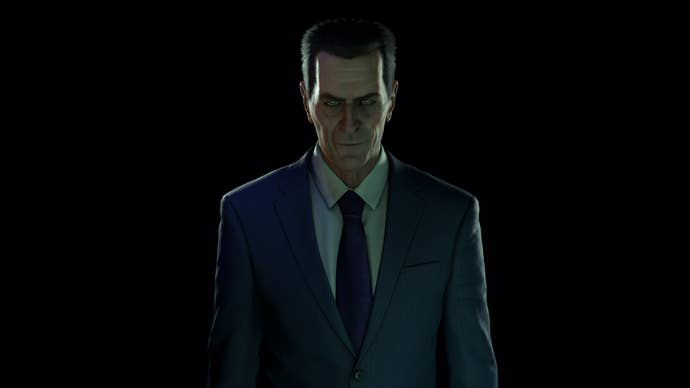
After the credits roll, the story picks back up five years later from the perspective of Gordon Freeman. At White Forest base, Gordon, Eli, and Dog realize that Alyx has been plucked from that point in time by the G-Man, on whom Eli swears his vengeance.
"Some of it was a little bit of desperation," says Wolpaw of settling on this ending. "We had two problems: one is, it's a prequel, and we've got these characters where you know their fate, so how do you set up any stakes for them? Secondly, the whole plot revolved around the idea that you're basically breaking God or Satan out of prison, and he owes you a favor. What's he going to do?
"Believe us, when we first thought of it, we were like 'no, we're not going to keep this.' Then we kept [thinking] no, wait, we could do this. We may have even pitched it to Chris this way; everyone we pitched to, we said, 'We're about to pitch you this ending, and you're gonna hate it, but just sit on it for a second. Just think about it.'"
"I think Erik's suspicion was correct," adds Remo. "That the initial reaction is like, 'Uh, what?' I think, for me, there's always been [...] sort of a slightly weird, metaphysical, out of space-and-time thread running through the games. Not as the core engine of the story or anything like that, but there are a few big tonal things that Half-Life has in it. One of them is action/horror/sci-fi, high intensity pacing, and then one is this almost incredibly austere science fiction. I think that's really what Marc Laidlaw—again, from the outside—what Laidlaw brought to this.
"Then, with the G-Man, you've got this odd, wildcard, metaphysical 'everything about this world is shifting and uncertain.' Everything that's happening is one smaller, weird thing inside an even bigger, strange series of events that as a player you're only dimly aware of. There are things happening on this cosmic scale that you have no sense of. I feel like the ending to this game, what those guys have come up with, I feel slots really well into that."
Wolpaw says that at Valve, others did take their time in coming around to the idea of rewriting Episode Two's ending with Half-Life: Alyx. "After the kneejerk 'no,' people would be like 'yeah, I think that would work,'" he says. "Again, once you present it as a problem to someone that we're breaking the G-Man out of prison, and he needs to do something for you, it's got to be something important, so what is it? We can't just fade to black there and nothing happens. Something has to happen."
"The Consequences Are Strange and Difficult to Predict"
The ending solves both problems: G-Man's offer to save her father's life is certainly one Alyx would take, and by changing the fate of two main characters, Half-Life: Alyx takes a running leap over the prequel issue. Whether or not it sticks the landing is for players to decide.
"It's important that it's not just a genie out of the bottle, snap your fingers and anything you want can happen whenever," Remo says. "There's just the ability to shift this one particular thing, and as usual, the consequences are strange and difficult to predict, and not necessarily what you want them to be."
"And it gets you thinking," adds Wolpaw. "There's so many things to think about at the end [with] timeline stuff. The writers have their own opinions about what's going on, but I kind of would just like to hear people talk about it, so I don't want to say too much." Given the decade-plus wait for a new Half-Life game and the existence of former series writer Marc Laidlaw's "Epistle 3" story treatment—which designer Robin Walker recently told Kotaku was never the sole direction a sequel could have gone in—fans will likely be grappling with their feelings and theories about Half-Life: Alyx for quite a while.
"Because we're making a game centered around Alyx, it just didn't—" Wolpaw stops. "None of the writers wanted for her to end up where she is [in Half-Life 2: Episode Two]. We wanted to set her off on a new trajectory that could be really interesting."
While there are Half-Life fans who are upset about the ending, having either just completed the game or who spoiled it for themselves, the consensus amongst critics on Half-Life: Alyx and its ending has been largely positive. Half-Life: Alyx promises that a future installment could hit the ground running with raised stakes, a new purpose, and a clear antagonist in the G-Man. It differs greatly from the direction of Marc Laidlaw's "Epistle 3," but there are some parallels. That story that also ends with the G-Man taking Alyx as a new "hire" while leaving Gordon behind—it's worth noting that Laidlaw did chat about the story with Wolpaw and the other writers during Half-Life: Alyx's development.
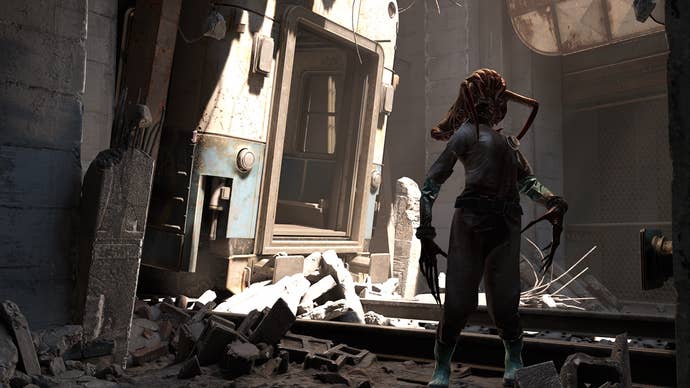
"Epistle 3" aside, with audience expectations for a true sequel to Episode Two so high, there's no way Half-Life: Alyx or a theoretical follow-up could satisfy everyone. Would a true Portal crossover by way of Aperture Science's Borealis research vessel even work after 2011's Portal 2 widened the gap between its tone and Half-Life's? Eli's death was a compelling story beat, but would a race against time and the Combine in the arctic have allowed for a serious exploration of Alyx's grief? For all the timeline fuzziness and intrigue Half-Life: Alyx introduces, most Half-Life fans should be glad of one thing regardless of their thoughts on the ending. As Wolpaw and Remo say, lots of people at Valve want to make more Half-Life.
For what it's worth, Wolpaw jokes that Half-Life: Alyx could've ended in a way that would've caused an absolute internet meltdown: "We did have one idea, which was at the end when [Alyx] says 'I want the Combine off of Earth,' G-Man says 'okay,' and then that's it. Half-Life 3, it's over. They're off Earth, and we end the series."
Wherever Half-Life goes next—if it does go somewhere—at least everyone was spared from that timeline.
For more on Half-Life: Alyx's story, head over to our full spoiler guide. It has some important context from past games that you may have forgotten, and also a tidbit from Wolpaw about the mysterious scientist Alyx overhears speaking to a Combine Advisor in a late-game chapter.






